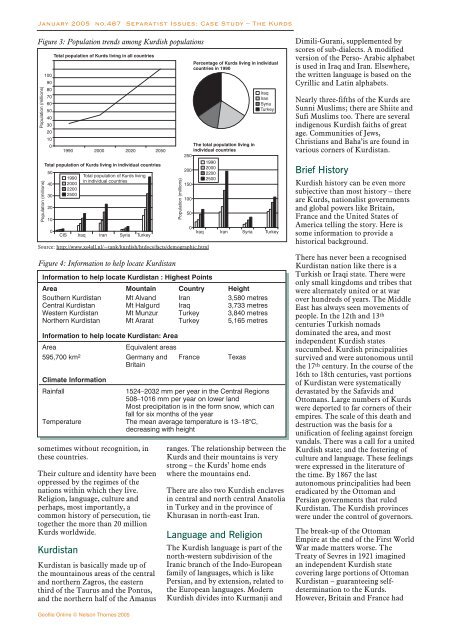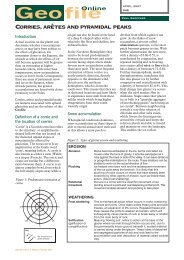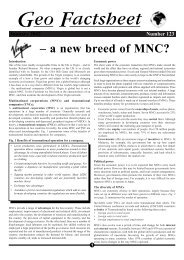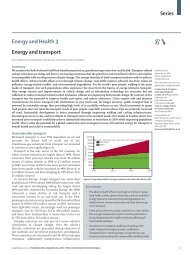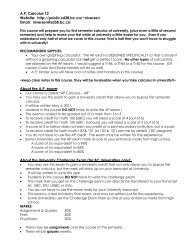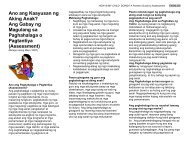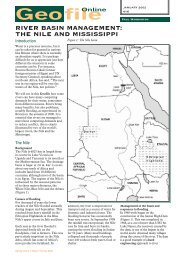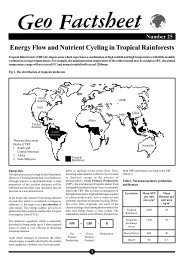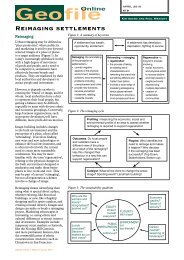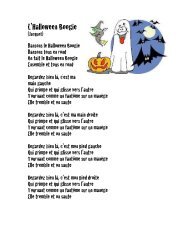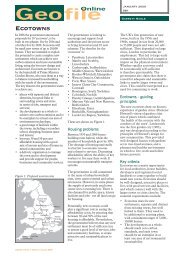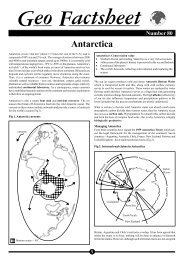Separatist Issues: Case Study â The Kurds - School-Portal.co.uk
Separatist Issues: Case Study â The Kurds - School-Portal.co.uk
Separatist Issues: Case Study â The Kurds - School-Portal.co.uk
Create successful ePaper yourself
Turn your PDF publications into a flip-book with our unique Google optimized e-Paper software.
January 2005 no.487 <strong>Separatist</strong> <strong>Issues</strong>: <strong>Case</strong> <strong>Study</strong> – <strong>The</strong> <strong>Kurds</strong><br />
Figure 3: Population trends among Kurdish populations<br />
Population (millions)<br />
Population (millions)<br />
100<br />
90<br />
80<br />
70<br />
60<br />
50<br />
40<br />
30<br />
20<br />
10<br />
0<br />
50<br />
40<br />
30<br />
20<br />
10<br />
0<br />
Total population of <strong>Kurds</strong> living in all <strong>co</strong>untries<br />
sometimes without re<strong>co</strong>gnition, in<br />
these <strong>co</strong>untries.<br />
<strong>The</strong>ir culture and identity have been<br />
oppressed by the regimes of the<br />
nations within which they live.<br />
Religion, language, culture and<br />
perhaps, most importantly, a<br />
<strong>co</strong>mmon history of persecution, tie<br />
together the more than 20 million<br />
<strong>Kurds</strong> worldwide.<br />
Kurdistan<br />
1990 2000 2020 2050<br />
Total population of <strong>Kurds</strong> living in individual <strong>co</strong>untries<br />
1990<br />
2000<br />
2200<br />
2500<br />
Total population of <strong>Kurds</strong> living<br />
in individual <strong>co</strong>untries<br />
CIS Iraq Iran Syria Turkey<br />
Source: http://www.xs4all.nl/~tank/kurdish/htdocs/facts/demographic.html<br />
Figure 4: Information to help locate Kurdistan<br />
Kurdistan is basically made up of<br />
the mountainous areas of the central<br />
and northern Zagros, the eastern<br />
third of the Taurus and the Pontus,<br />
and the northern half of the Amanus<br />
Population (millions)<br />
<strong>The</strong> total population living in<br />
individual <strong>co</strong>untries<br />
250<br />
1990<br />
2000<br />
200<br />
2200<br />
2500<br />
150<br />
100<br />
50<br />
0<br />
Percentage of <strong>Kurds</strong> living in individual<br />
<strong>co</strong>untries in 1990<br />
Iraq Iran Syria Turkey<br />
ranges. <strong>The</strong> relationship between the<br />
<strong>Kurds</strong> and their mountains is very<br />
strong – the <strong>Kurds</strong>’ home ends<br />
where the mountains end.<br />
<strong>The</strong>re are also two Kurdish enclaves<br />
in central and north central Anatolia<br />
in Turkey and in the province of<br />
Khurasan in north-east Iran.<br />
Language and Religion<br />
Iraq<br />
Iran<br />
Syria<br />
Turkey<br />
Information to help locate Kurdistan : Highest Points<br />
Area Mountain Country Height<br />
Southern Kurdistan Mt Alvand Iran 3,580 metres<br />
Central Kurdistan Mt Halgurd Iraq 3,733 metres<br />
Western Kurdistan Mt Munzur Turkey 3,840 metres<br />
Northern Kurdistan Mt Ararat Turkey 5,165 metres<br />
Information to help locate Kurdistan: Area<br />
Area<br />
Equivalent areas<br />
595,700 km 2 Germany and France Texas<br />
Britain<br />
Climate Information<br />
Rainfall<br />
Temperature<br />
1524–2032 mm per year in the Central Regions<br />
508–1016 mm per year on lower land<br />
Most precipitation is in the form snow, which can<br />
fall for six months of the year<br />
<strong>The</strong> mean average temperature is 13–18°C,<br />
decreasing with height<br />
<strong>The</strong> Kurdish language is part of the<br />
north-western subdivision of the<br />
Iranic branch of the Indo-European<br />
family of languages, which is like<br />
Persian, and by extension, related to<br />
the European languages. Modern<br />
Kurdish divides into Kurmanji and<br />
Dimili-Gurani, supplemented by<br />
s<strong>co</strong>res of sub-dialects. A modified<br />
version of the Perso- Arabic alphabet<br />
is used in Iraq and Iran. Elsewhere,<br />
the written language is based on the<br />
Cyrillic and Latin alphabets.<br />
Nearly three-fifths of the <strong>Kurds</strong> are<br />
Sunni Muslims; there are Shiite and<br />
Sufi Muslims too. <strong>The</strong>re are several<br />
indigenous Kurdish faiths of great<br />
age. Communities of Jews,<br />
Christians and Baha’is are found in<br />
various <strong>co</strong>rners of Kurdistan.<br />
Brief History<br />
Kurdish history can be even more<br />
subjective than most history – there<br />
are <strong>Kurds</strong>, nationalist governments<br />
and global powers like Britain,<br />
France and the United States of<br />
America telling the story. Here is<br />
some information to provide a<br />
historical background.<br />
<strong>The</strong>re has never been a re<strong>co</strong>gnised<br />
Kurdistan nation like there is a<br />
Turkish or Iraqi state. <strong>The</strong>re were<br />
only small kingdoms and tribes that<br />
were alternately united or at war<br />
over hundreds of years. <strong>The</strong> Middle<br />
East has always seen movements of<br />
people. In the 12th and 13 th<br />
centuries Turkish nomads<br />
dominated the area, and most<br />
independent Kurdish states<br />
succumbed. Kurdish principalities<br />
survived and were autonomous until<br />
the 17 th century. In the <strong>co</strong>urse of the<br />
16th to 18th centuries, vast portions<br />
of Kurdistan were systematically<br />
devastated by the Safavids and<br />
Ottomans. Large numbers of <strong>Kurds</strong><br />
were deported to far <strong>co</strong>rners of their<br />
empires. <strong>The</strong> scale of this death and<br />
destruction was the basis for a<br />
unification of feeling against foreign<br />
vandals. <strong>The</strong>re was a call for a united<br />
Kurdish state; and the fostering of<br />
culture and language. <strong>The</strong>se feelings<br />
were expressed in the literature of<br />
the time. By 1867 the last<br />
autonomous principalities had been<br />
eradicated by the Ottoman and<br />
Persian governments that ruled<br />
Kurdistan. <strong>The</strong> Kurdish provinces<br />
were under the <strong>co</strong>ntrol of governors.<br />
<strong>The</strong> break-up of the Ottoman<br />
Empire at the end of the First World<br />
War made matters worse. <strong>The</strong><br />
Treaty of Sevres in 1921 imagined<br />
an independent Kurdish state<br />
<strong>co</strong>vering large portions of Ottoman<br />
Kurdistan – guaranteeing selfdetermination<br />
to the <strong>Kurds</strong>.<br />
However, Britain and France had<br />
Geofile Online © Nelson Thornes 2005


